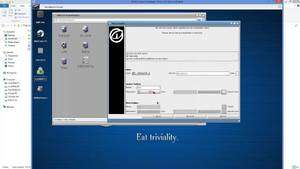
- Qemu system arm windows install#
- Qemu system arm windows driver#
- Qemu system arm windows code#
- Qemu system arm windows password#
Qemu system arm windows code#
In addition to C/C++ and Python, you can also write code using Node. If you want to release the mouse from QEMU window, press Ctrl+Alt. You can write code in Python and C/C++ without any extra packages: If you want to go back to command line mode, click the quit button and select Logout: You can type ‘startx’ to launch a graphical session:
Qemu system arm windows password#
Downloadsĭownload and unzip the package qemu.zip, and then double-click run.bat to launch the emulator:īy default the username is pi, and the password is raspberry. For the case that you want to switch work frequently between Windows and Raspbian, using the emulator QEMU may be a better choice. If you use Raspbian – the official supported Linux system, you can connect your keyboard, mouse, cable and display monitor to the board and directly write code on the small device.

Qemu system arm windows install#
If flashing Windows 10 IoT core on Raspberry Pi, you can build IoT projects with Visual Studio 2015 and remotely debug your code. qemu-arm -cpu The Qemu provided by your Linux distribution should just work (tested on latest Linux Mint - apt-get install qemu-system-arm). More and more students and developers tend to study and work using Raspberry Pi, which supported by Windows and Linux. The new RPi device added Bluetooth and Wi-Fi. Then wait a long time, its dead slow.Raspberry Pi 3 has been released for a while. Although you can assign more cpu’s as your hardware has, it does not make a lot of sense.
-m 4048 -smp 4 : means 4048 MB of memory and 4 cpu cores, you may change this to fit your hardware better. The Windows versions of xPack QEMU Arm are packed as ZIP files. You may omit -nographic -serial mon:stdio if you do not use a ansi-color aware terminal emulator. Omit the last line (-net nic -net tap,ifname=EthernetTap) if you did not setup a tap network interface, it will boot but has no network. OpenOCD, pyocd, and QEMU), plus a number of templates to create ready to. append "console=ttyAMA0 rw root=/dev/vda2 verbose" ^ The Eclipse Installer 202206 R now includes a JRE for macOS, Windows and Linux. Set PATH=%PATH% C:\Program Files\qemu\ qemu-system-arm -m 4048 -smp 4 -M virt ^ Share the connection of the active network interface with the tap-interface ( select network interface properties > share tab). Create a bridge between the tap-interface and the active network interface (select them both right click choose bridge connection). unpack ramdisk ( uInitrd-5.10.12-sunxi) + kernel ( vmlinuz-5.10. unpack device tree (dtb) into folder dtb. In Control Panel\Network and Internet\Network Connections: use qemu-system-arm on debian-buster and a specified cpu armv7 like H3 NanoPi NEO Core-LTS (same like orangepi) before starting: download armbian image for H3. Optional: (There may be better ways to get network functionality) Open the qcow2 file (with 7zip) and extract the kernel (vmlinuz-…) and initramfs (initramfs-…img) from the first partition to your folder. Decompress the downloaded image in a convenient folder. Qemu system arm windows driver#
A tap network adapter driver like OpenVPN installs. A ansi color ESC sequence aware terminal-emulator like cmder. (technically from the available system emulators only qemu-system-arm is a necessity) Once everything is done, start QEMU with these parameters: set HDDwindows-on-arm.vhd set qemu-system-arm -M virt -cpu cortex-a15 -smp 2 -accel tcg,threadmulti -m 2G -bios QEMUEFI1512.fd -device VGA -device ich9-usb-ehci1 -device usb-kbd -device usb-tablet -drive ifvirtio,fileHDD.  Qemu 2.12 for windows, note with the latest version 3.0.0 network did not work for me. A (de)compression utility like 7zip able to process tar.xz and qcow2. It is so utterly slow I can not think of a use case… JustBecauseItsPossible A complete useless how-to run an emulated centos arm virtual machine on windows 10.
Qemu 2.12 for windows, note with the latest version 3.0.0 network did not work for me. A (de)compression utility like 7zip able to process tar.xz and qcow2. It is so utterly slow I can not think of a use case… JustBecauseItsPossible A complete useless how-to run an emulated centos arm virtual machine on windows 10.






 0 kommentar(er)
0 kommentar(er)
